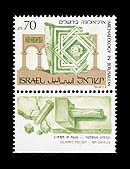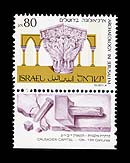|
|
Jerusalem has been extolled and glorified since time immemorial. More than any other city in the world, it has been crowned with honour and wreathed in praises. Jerusalem has been called "The City of God", "The Eternal City", "City of the Prophets", "City of Soul and Spirit", "City of Beauty", and a great many other laudatory appellations.
Dedicated archaeologists, probing the secrets of Jerusalem's checkered past, have unearthed artifacts from a plethora of human cultures dating back through all the ages of Mankind. Since the city's very beginnings, the fine stonework of Jerusalem - its ancient reliefs and capitals - has borne silent witness to the skill and pride of its artists and masons.
Relief from the palace of Umayade Caliphs - 8th century
In the 8th century a large-scale palatial quarter was built south of the Temple Mount. In its centre was the palace of the Caliph (Dar-el-Imara). This palace was richly decorated with frescos and stone reliefs. These excelled in carvings of stylised geometrical and floral designs.
The 70 ag. stamp shows a geometrical relief with a rosette in its centre. This relief has been carved in soft Jerusalem stone; it used to be part of the external wall decorations of the palace.
Marble Capital from the Church of Ascension on the Mount of Olives - l2th-l3th centuries
In the 12th century the Crusaders reconstructed the Church of Ascension on the Mount of Olives. The traditional place of Ascension was already believed to be there in the Byzantine period (4th - 7th centuries).
In the centre of the Church, the Crusaders erected a simple domed structure to mark the exact spot of the Ascension. This, which still stands today, has small marble columns crowned by fine capitals. On one of these capitals, winged mythological animals can be seen carved out of the stone. Floral patterns were added and a stripe with a floral element decorates the top of the capital - a beautiful example of Crusader art from 12th century Jerusalem.


